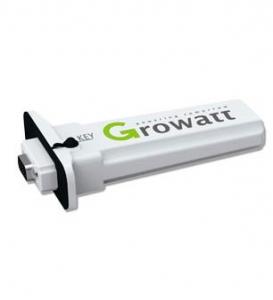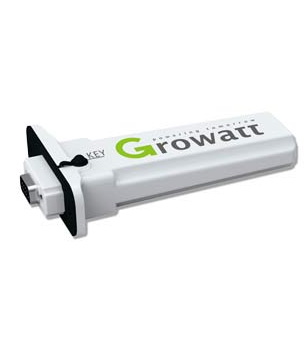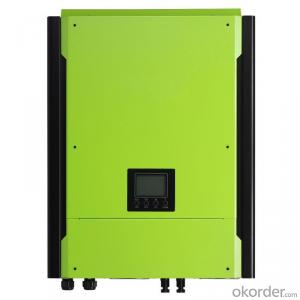Solar Inverter Replacement Brisbane - Shine Wi-Fi, Solar System Monitoring, Remote Control
- Loading Port:
- Shekou
- Payment Terms:
- TT OR LC
- Min Order Qty:
- 100 watt
- Supply Capability:
- 1000000 watt/month
OKorder Service Pledge
OKorder Financial Service
You Might Also Like
Shine Wi-Fi, Solar System Monitoring, WIFI
Professional monitor through Internet and environment
100-meter wireless connection to inverter
Easy-to use
Every inverter installed with Wi-Fi can be monitored in your own project
Remote setting and updating
Cost-effective
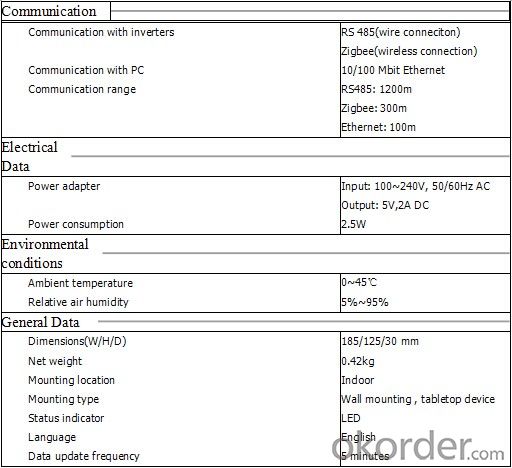
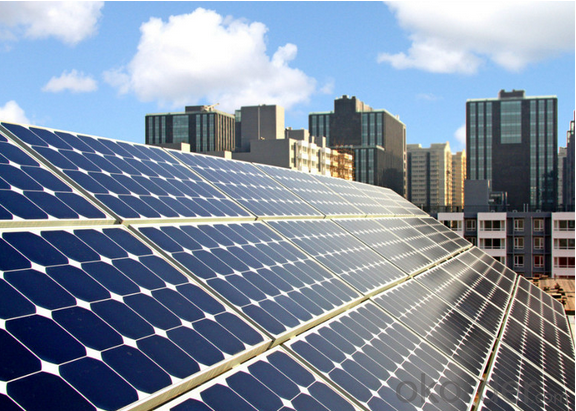
FAQ
Is solar power difficult to use?
Although the production of solar panels incorporates a high-tech manufacturing process, it is really very easy to use a photovoltaic system. Solar panels have no moving parts to wear out, they can be used alone or in combination with other energy sources, and they are silent, reliable and long lasting.
What can you power with Photovoltaics?
A properly designed photovoltaic system can supply electricity for many applications, from small remote lighting needs to megawatts of power for large utility companies. An advantage of photovoltaic power is that it can do anything a traditional power generator can do, only without consuming pollution-causing fuel, or requiring noisy motors.
What is a PV system?
A PV system consists of all the equipment and materials needed to generate solar energy, including solar panels (often called modules), a support structure, wiring, an inverter, a meter and other equipment as required by a specific application. JUST-SOLAR's PV system for commercial buildings, and ET Solar system for residential uses are examples of complete PV systems.
What is a solar module?
Solar modules are series of solar cells, wired together and enclosed protect them from the environment. They are often referred to as in self-contained glass units to solar panels as well.
How do solar cells work?
Solar cells are solid-state devices in which photons (or packets of light) collide with atoms. This process transforms the resulting into electrons. These electrons flow into wires connected to the cell, thus providing electric current to appliances, lighting systems or other electrical loads; and all of the power comes directly from the sun.
What is Photovoltaic Power?
Photovoltaic (PV) power is a term used to describe the process of converting sunlight into electricity with solar cells. These cells are specially constructed from semiconductor materials, and are treated to generate a flow of electricity when sunlight shines on them
- Q: What are the safety measures to consider when installing a solar inverter?
- Some safety measures to consider when installing a solar inverter include: 1. Proper grounding: Ensure that the inverter is properly grounded to prevent electrical shocks and to maintain system stability. 2. Compliance with electrical codes: Adhere to local electrical codes and regulations to ensure safe installation and minimize the risk of electrical hazards. 3. Disconnecting power: Before starting the installation, make sure to disconnect power from the solar panels and the grid to avoid electrical accidents. 4. Proper ventilation: Install the inverter in a well-ventilated area to prevent overheating and potential fire hazards. 5. Adequate wiring: Use appropriate wire sizes and proper connections to handle the current capacity of the inverter and minimize the risk of electrical short circuits or fires. 6. Surge protection: Install surge protectors to safeguard the inverter and connected devices against power surges and lightning strikes. 7. Regular maintenance: Perform routine maintenance and inspections to ensure the inverter is functioning properly and to identify any potential safety issues. 8. Qualified installation: It is recommended to have the solar inverter installed by a qualified professional who is knowledgeable about electrical systems and safety measures. By following these safety measures, the risk of electrical accidents or system malfunctions can be minimized, ensuring a safe and reliable solar inverter installation.
- Q: Can a solar inverter be used with a solar tracker system?
- Yes, a solar inverter can be used with a solar tracker system. A solar inverter is responsible for converting the direct current (DC) produced by solar panels into alternating current (AC) that can be used to power electrical devices. A solar tracker system, on the other hand, is designed to maximize the efficiency of solar panels by orienting them towards the sun throughout the day. By using a solar inverter in conjunction with a solar tracker system, the generated electricity can be efficiently converted and used for various applications.
- Q: How does the efficiency of a solar inverter affect the overall system performance?
- The efficiency of a solar inverter plays a critical role in determining the overall system performance. A higher efficiency inverter converts a greater percentage of the incoming solar energy into usable electricity, resulting in increased energy production. This ultimately leads to higher system output and improved performance. Additionally, a more efficient inverter reduces energy losses and improves the overall system's reliability and longevity. Lower efficiency inverters, on the other hand, can result in energy wastage and reduced system performance. Therefore, selecting a highly efficient solar inverter is essential for maximizing the overall performance and energy output of a solar power system.
- Q: What is the role of a power management system in a solar inverter?
- The role of a power management system in a solar inverter is to optimize the generation, distribution, and usage of solar power. It ensures efficient energy conversion, monitors the solar panel performance, manages the flow of electricity to and from the grid, and maximizes the overall system efficiency. Additionally, it may include features such as power factor correction, voltage regulation, and protection mechanisms to enhance the reliability and safety of the solar inverter.
- Q: How does the input voltage rating affect the performance of a solar inverter?
- The input voltage rating is a critical factor in determining the performance of a solar inverter. The inverter's ability to convert the direct current (DC) generated by solar panels into alternating current (AC) for use in homes or businesses depends on the input voltage rating. If the input voltage rating of the inverter is not compatible with the voltage produced by the solar panels, the inverter may not function properly or may even be damaged. Thus, selecting an inverter with the correct input voltage rating is essential for optimal performance and longevity of a solar power system.
- Q: Can a solar inverter be used with a solar-powered water pump?
- Yes, a solar inverter can be used with a solar-powered water pump. A solar inverter converts the direct current (DC) generated by solar panels into alternating current (AC) that can be used to power various electrical devices, including water pumps. This allows the solar panels to directly power the water pump, making it an efficient and sustainable solution for water pumping applications.
- Q: How does a solar inverter handle variations in AC load demand?
- A solar inverter handles variations in AC load demand by continuously monitoring the load demand and adjusting the amount of power it delivers from the solar panels accordingly. This is achieved through advanced control algorithms that optimize the conversion of DC power generated from the solar panels into AC power that matches the load demand. The inverter maintains a stable voltage and frequency output, ensuring that the electrical devices connected to it receive a consistent and reliable power supply, even when there are fluctuations in the AC load demand.
- Q: What is the role of a power limiter in a solar inverter?
- The role of a power limiter in a solar inverter is to regulate and limit the amount of power that can be generated and fed back into the electrical grid. It ensures that the solar system does not exceed the permitted power limits set by the utility company or regulatory authorities, preventing any potential damage to the grid infrastructure. Additionally, a power limiter helps maintain a stable and reliable power supply by controlling the amount of solar energy that is being exported or utilized within a specific threshold.
- Q: What is the power factor of a solar inverter?
- The power factor of a solar inverter refers to the ratio between the real power and the apparent power. It indicates how effectively the inverter converts the DC power generated by solar panels into AC power. A high power factor (close to 1) indicates efficient power conversion, while a low power factor (close to 0) signifies poor conversion efficiency.
- Q: How does a solar inverter handle voltage fluctuations during grid disturbances?
- A solar inverter handles voltage fluctuations during grid disturbances by continuously monitoring the grid voltage. When a disturbance occurs, such as a sudden drop or increase in voltage, the inverter's control system detects it and adjusts the output voltage accordingly. This allows the inverter to stabilize the voltage and ensure a consistent supply of electricity to the connected solar panels or the grid.
Send your message to us
Solar Inverter Replacement Brisbane - Shine Wi-Fi, Solar System Monitoring, Remote Control
- Loading Port:
- Shekou
- Payment Terms:
- TT OR LC
- Min Order Qty:
- 100 watt
- Supply Capability:
- 1000000 watt/month
OKorder Service Pledge
OKorder Financial Service
Similar products
Hot products
Hot Searches
Related keywords
